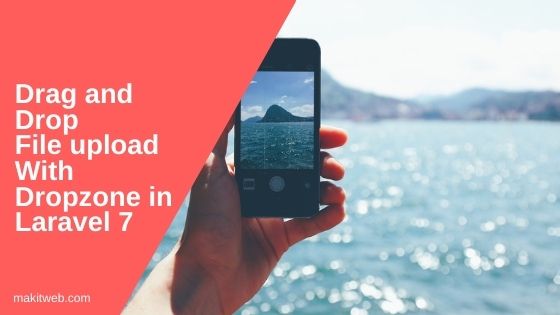Dropzone is easier to add on the page. It allows either uploading the file by drag & drop or file browse. It displays file preview after upload.
In Laravel, need to also pass the CSRF token for uploading the files.
In this tutorial, I show how you can upload a file using dropzone in Laravel 7.

Contents
1. Download
- Download Dropzone library from here
- Extract the downloaded files in
public/folder. - You can also CDN –
<script src="https://unpkg.com/dropzone@5/dist/min/dropzone.min.js"></script> <link rel="stylesheet" href="https://unpkg.com/dropzone@5/dist/min/dropzone.min.css" type="text/css" />
2. Route
- Open
routes/web.phpfile. - Define 2 routes –
Route::get('/','UsersController@index');
Route::post('/users/fileupload/','UsersController@fileupload')->name('users.fileupload');
- The 2nd route is used for Dropzone file upload.
3. Controller
- Create
UsersControllerController.
php artisan make:controller UsersController
- Open
app/Http/Controllers/UsersController.phpfile. - Import
Carbon\Carbon. - Create two methods –
- index – Load
users.indexview. - fileupload – This method is used to upload the selected file of Dropzone.
- index – Load
Assign upload location to $destinationPath variable.
Get the file extension and initialize valid file extension in $validextensions Array.
Check the file extension is exists in $validextension Array. If exists then rename the file and upload it.
Completed Code
<?php
namespace App\Http\Controllers;
use Illuminate\Http\Request;
class UsersController extends Controller {
public function index(){
return view('users.index');
}
/*
File upload
*/
public function fileupload(Request $request){
if($request->hasFile('file')) {
// Upload path
$destinationPath = 'files/';
// Get file extension
$extension = $request->file('file')->getClientOriginalExtension();
// Valid extensions
$validextensions = array("jpeg","jpg","png","pdf");
// Check extension
if(in_array(strtolower($extension), $validextensions)){
// Rename file
$fileName = $request->file('file')->getClientOriginalName().time() .'.' . $extension;
// Uploading file to given path
$request->file('file')->move($destinationPath, $fileName);
}
}
}
}
4. View
Create file –
- Create a new folder
usersatresources/views/folder. - In
resources/views/users/folder create a newindex.blade.phpfile.
Include CSS and JS –
- Specify
csrf_token()in the<meta >. - Include Dropzone CSS and JS files at the
<head >section.
Dropzone container –
- Create
<form class='dropzone' >. Pass{{route('users.fileupload')}}inactionattribute.
Script –
- Read CSRF token from
<meta >tag and assign inCSRF_TOKENvariable. - Disable dropzone auto-discovery by assigning false –
Dropzone.autoDiscover = false;. - Initialize dropzone on
class='dropzone'. Set max upload file size to 3 MB and upload file extensions – jpeg, jpg, png, and pdf. - Use dropzone
'sending'event to passCSRF_TOKENwith formData –formData.append("_token", CSRF_TOKEN).
Completed Code
<!DOCTYPE html>
<html>
<head>
<title>Drag and Drop file upload with Dropzone in Laravel 7</title>
<!-- Meta -->
<meta http-equiv="Content-Type" content="text/html; charset=UTF-8">
<meta charset="utf-8">
<meta name="csrf-token" content="{{ csrf_token() }}">
<!-- CSS -->
<link rel="stylesheet" type="text/css" href="{{asset('dropzone/dist/min/dropzone.min.css')}}">
<!-- JS -->
<script src="{{asset('dropzone/dist/min/dropzone.min.js')}}" type="text/javascript"></script>
</head>
<body>
<div class='content'>
<!-- Dropzone -->
<form action="{{route('users.fileupload')}}" class='dropzone' >
</form>
</div>
<!-- Script -->
<script>
var CSRF_TOKEN = document.querySelector('meta[name="csrf-token"]').getAttribute("content");
Dropzone.autoDiscover = false;
var myDropzone = new Dropzone(".dropzone",{
maxFilesize: 3, // 3 mb
acceptedFiles: ".jpeg,.jpg,.png,.pdf",
});
myDropzone.on("sending", function(file, xhr, formData) {
formData.append("_token", CSRF_TOKEN);
});
</script>
</body>
</html>
5. Output
6. Conclusion
You need to pass the CSRF token to upload the file using Dropzone. For this require to explicitly initialize dropzone and pass the token.
If you found this tutorial helpful then don't forget to share.